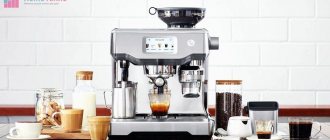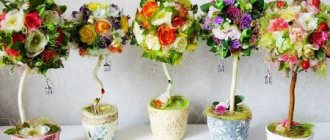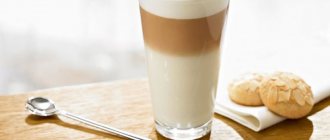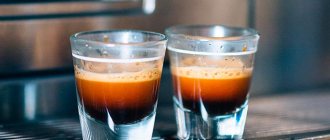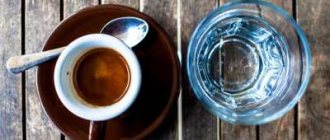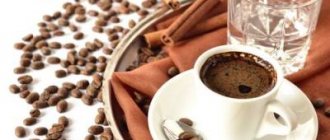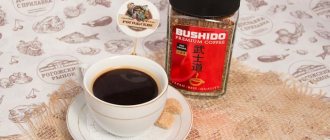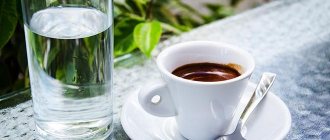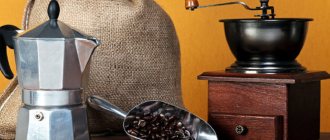Today, the confusion with mugs and cups continues to be relevant. In one country, the utensil for drinking tea and coffee is called a cup, because it looks more like a bowl, and in another - a mug. We have to figure out whether there is a fundamental difference right now.
In one country, the utensil for drinking tea and coffee is called a cup, because it looks more like a bowl, and in another it is called a mug.
From the history of mugs-cups
Much that explains to us the differences between vessels that are essentially identical in appearance and purpose can be found in the history of the creation of these drinking utensils.
First cups
As the first cups, people used all sorts of devices that vaguely resembled modern cups: these were the horns of wild animals, the shells of ostrich eggs, later clay cups and products made from a single piece of amber appeared. Yes, such dishes looked quite impressive, but drinking from them was hardly very convenient. Firstly, such cups could not be placed on a flat surface and had to be constantly held in the hand. Secondly, such cups practically did not retain the heat of the contents. The very first cup, as history claims, was given to the world by China - it was intended for drinking expensive and rare drinks, to which only the nobility and people from high society had access. This cup was made of clay or porcelain, it did not have a handle, and its shape was more like a saucer.
The handle was “attached” to the cup by the British in the 18th century - this made it possible to drink hot tea without burning your hands.
First mugs
The mug appeared long before cups and was an integral attribute of both peasants and rich people. Mug means “jug” in Polish. This is because the first mugs had a distinctive spout and lid. The lid served peasants in the field as protection against insects getting into their drink. These mini jugs, or the ancestors of modern mugs, appeared in the 15th century and were cylindrical in shape. Due to its large volume (up to 500 ml), the mug served as a vessel for water from which food was prepared.
In pagan times, mugs were measures of the volume of liquid, so a mug without a handle of large volume was called a glass and was intended for serving mead.
Adviсe
- To get rid of stains on cups and dishes made of porcelain with a subtle gold pattern, you should wipe the dishes with a soft cloth and soda. If the contamination is minor, then the cup or saucer can be washed with water and vinegar.
- Porcelain dishes will retain their original whiteness longer if they are periodically immersed in vinegar or soda solution.
- A narrow cup with thick walls keeps tea hot longer. In a wide cup with thin walls, the drink cools much faster.
The main differences between a mug and a cup:
- The thickness of the walls of the mug is greater than that of the cup. The cups are thinner and more elegant, the tea cools faster in them
- An important difference is the volume: for a cup it is up to 180-200 ml, and a mug can be up to 500 ml
- The cup, as a rule, comes with a saucer, and the mug is sold alone. This is because when the edges of the thin cup are heated, the tea is poured into the saucer. A mug does not have such a need, so according to etiquette it is not customary to serve it with a saucer. The mug must have a handle and a stable bottom
- Antique cups have two handles on the sides. By the way, there are also modern two-handed models of cups
- Cups are more often used for ceremonial serving or in catering establishments (cafes, restaurants). Mugs are more practical and popular in daily life
- The mugs are universal and suitable for drinking any drinks in large quantities. The same cannot be said about cups: they are intended for tasting rare varieties of tea and coffee, as well as for official receptions and demonstrating respect for the guest
- The cup has a spherical shape and is lower, and the mug is always oblong or conical and tall
Volume of the dishes in question
A mug, cup, glass and glass can, in principle, have the same capacity. But most often their volume is different.
The usual capacity of a mug is 250–500 cm³ (there are also liter ones). One of the reasons why express printing on mugs is in demand is the large size of the product, which allows fairly large designs to be applied to it.
A cup is a small vessel with a volume of approximately 200 cm³. Moreover, this parameter depends on the purpose:
- Tea rooms (also used for serving cocoa, chocolate, coffee with milk) can hold 200-250 cm³.
- Coffee shops that serve black coffee have a volume of 75-100 cm³, and for oriental coffee 50-70 cm³.
- Bouillon bottles , which usually have 2 handles, hold 350-400 cm³.
From left to right: tea, coffee and broth cups
As a rule, 200-250 cm³ of liquid is placed in a glass, and the capacity of the glasses is determined by the drink that is drunk from it:
- For champagne - from 125 to 200 ml.
- For juices and cocktails – from 200 to 350 ml.
- For beer (maybe without a stem) - 250-500 ml.
What drinks are cups and mugs intended for:
In fact, the culture of drinking today allows you to choose a convenient way to drink. But still, based on the differences in vessels, there are drinks that are more convenient to drink from a mug, and there are those that are only suitable for a cup
- It’s still more convenient to drink coffee or strong tea from a small cup
- The mug, thanks to its large volume, does not pose any obstacles to the choice of contents. It is convenient to drink large amounts of tea from a mug and, if you want to extend your tea drinking, this is because the thick walls of the mug retain heat longer. Also, you can not only drink a prepared drink from a mug, but also brew it in it (mugs with strainers for brewing)
- Mugs are more convenient for cocoa with or without additives, for cold or hot drinks, and from some mugs you can even drink broths and other first cold or hot dishes
Purpose of the mug
Modern technologies make it possible to produce mugs not only for drinking drinks, but also for long-term heat retention, creating individual prints, photographs on the walls of the dishes and printing inserts for every taste, including changing the color of the walls “chameleon”.
For fun, craftsmen potters produce joke mugs. In appearance they are not at all different from ordinary ones. At the same time, it is simply impossible to drink from them without spilling a single drop. When making it, the craftsman leaves several holes in the handle and bottom. Only knowing the secret of the location of these holes can you stay dry.
Mugs have no division by purpose. They are used for any drinks: hot and cold. The exception is beer mugs, which are produced only from glass or ceramics and are often supplemented with a lid. They have a maximum volume of up to 1 liter.
Recommendations for tea lovers:
- A porcelain cup enhances the aroma of tea and adds solemnity to tea drinking
- It is believed that the volume of the cup should not exceed 100 ml in order to reveal the taste and aroma of the drink at its optimal temperature. The additional volume of such a cup allows you to add milk or cream to tea, which cannot be said about 20-30 ml bowls for the Chinese tea ceremony
- For the Chinese tea ceremony, you must choose a cup without a bowl type handle; it should fit in your palm
- The choice of tea cup depends largely on the country in which the tea party takes place: green tea - from traditional Chinese dishes, black - from wide and voluminous cups with handles
- Due to the high caffeine content (more than coffee!), tea is usually drunk after meals.
- Black tea should not be brewed twice
- It is not recommended to interrupt the delicate taste of green tea with sweets. So, it’s better to serve a nut mix or a bowl of fresh fruit with a cup of green tea.
- But black tea accepts whatever your heart desires - from light marshmallows to high-calorie cake or chocolate
How to choose correctly
The choice of this category of kitchen utensils is determined by the personal preferences of the buyer. Form and design are taken into account here. For example, a cup with a lid for tea is interesting, but it is unlikely that it will look harmonious on the table in tandem with other elements of the service.
The shape of the cup is determined by how comfortable it is to hold. The material and color background, they must match the design of the kitchen and be combined with other elements of the tea set (teapot, sugar bowl, milk bowl, and so on).
Choose based on volume and size. It is believed that small containers help to experience the true taste of the tea drink and feel its aroma. For those who like to add other ingredients to their tea, such as milk, you should choose larger cups.
It is believed that small containers help to experience the true taste of the tea drink and feel its aroma.
The ideal option is to purchase a ready-made tea set, designed for an average of 6, 12 or 19 people (standard filling form), but manufacturers offer very nice and original models that can serve not only as an assistant in relaxation, but also as a worthy gift for a loved one .
Grand-Lux bestsellers
Oxford cup 100ml – 160 rub.
Juicy peach – love at first sight!
This particular shade is the hit of the season and the top seller this season. A mug made of high-quality porcelain retains heat, is resistant to cracks and chips and will last a long time, delighting with its practicality and unique appearance.
Set of Crystalite Bohemia Origami cups 120 ml – 2080 rub.
“Crumpled paper” - this trend in tableware fashion has long won the hearts of lovers of originality and remains at its peak today. A miniature crystal glass cup will perfectly convey the unique shade of your favorite tea or coffee. It has a comfortable handle, a stable bottom and a universal design for any serving.
Tea cup Benedikt Silver 200ml – 870 rub.
Lilac is a favorite color among many fans of romantic tableware, which is suitable for everyday gatherings in the kitchen, and can also decorate a festive table with dignity. Decorate your tea party with a luscious palette of Benedikt mugs.
Set of cup and saucer Caroline Artigianato Ceramico Pumpkin – 2660 rub.
Cozy, like all Italian ceramics, and also practical - a cup from which you can not only drink, but also brew aromatic tea in it. It will not only be a practical addition to your kitchenware, but also a creative gift for a tea lover.
Tea pair Oxford 100ml – 920 rub.
The rigor of geometry gives rise to romantic decor. After all, tea is a whole philosophy of life, and Oxford porcelain is a philosophy of creating beauty from nature. Enjoy yourself too.
Mug Nela Time Geese jirka 300ml – 400 rub.
Especially for those who love more! Legendary design and large volume. Suitable for tea, cocoa, tea with milk or cream and everything you love so much.
Nela Time mug White pattern – 330 rub.
The large, very comfortable handle and delicate design of the mug in a minimalist style will make this product one of the most beloved in your kitchen. Relief embossing and high quality porcelain distinguish this mug with gold lining.
Barrel mug Royal Classics Huawei ceramics Bears — 290 rub.
The bears were riding a bicycle... Give your child such a barrel-shaped mug, and he will always like the contents. Warm milk, tea, jelly or compote - everything will be drunk to the bottom!
Quality and safety are confirmed by safety certificates.
Mug Queen's Crown Crown Wildflower 500 ml – 1300 rub.
The mug is very large. It is not only roomy and practical, but also spectacular - classic style decor and two handles on the sides distinguish this product and turn it into a work of tableware art. You should definitely have this “exhibit” in your kitchen.
Types of tea cups
With tea cups things are much simpler. Cups can be made of glass, porcelain, clay or ceramic. It is best to choose tea cups made of thick-walled porcelain, as this material retains heat very well.
Tea cups can be small in volume; such cups are also called tasting cups.
The ideal tea set is wide, medium-sized porcelain cups and saucers.
How do glass thermocups work?
To correctly choose high-quality double glass glasses, you need to have at least a little idea of how the fashionable Double Wall Glass Cups are structured and what they are made of.
Thermal glasses have a special design similar to a thermos . They consist of two glasses - external and internal, connected at the neck. This is clearly visible both in an empty glass and in a filled one. The inner vessel has its own walls and its own bottom. For beauty, manufacturers give the inner container other shapes, which makes it seem as if the liquid is whimsically floating in the air without touching the glass.
Between the inner and outer walls there is ordinary air. The air gap isolates the vessel with liquid from the external one, which is in the hands. This “pillow” prevents the outer container from heating up from the hot contents, and prevents the cold drink from cooling down and forming condensation on the surface.
Double glass glasses have a small but noticeable hole . Sometimes it appears to be sealed with silicone, but this is only partial insulation. Why is this hole needed?
The valve equalizes the difference between intrawall and atmospheric pressure. This is especially important for hot drinks that heat the air between the walls. Hot air is known to expand and can cause glass to crack. Do not seal or cover this hole under any circumstances
To produce double-walled glasses, thin borosilicate glass is used, which can withstand temperatures ranging from -20 to +150 degrees and even more. The raw material contains boron oxide, which gives the brittle material special properties without compromising its transparency.
Borosilicate glass is characterized by chemical resistance, resistance to high temperatures and a low coefficient of thermal expansion. This type of glass is used for laboratory equipment and heat-resistant cookware for open fires (teapots, pots, coffee makers).
Thermal glasses can be placed in the freezer, oven and microwave, and washed in the dishwasher. This will not affect their properties or appearance in any way. But despite all their resistance to temperature crises, thermal glass glasses are quite fragile. They should be stored carefully, not stacked one on top of the other, and not dropped. You should also not expose it to sudden changes in temperature.
Glass composition
The components that make up glass can be divided into the following types:
- The basis
- Mandatory alkali metal oxides
- Components that impart special properties
- Excipients
Also in some cases, cullet is added.
The basis of any glass is quartz sand or silicon dioxide. Moreover, only selected sand, purified from iron impurities and the slightest impurities, gets into the mixture for future glass; about 2% of impurities are allowed. The transparency of the glass itself depends on this.
The required alkali metal oxides vary depending on the type of glass. For example:
- oxides of sodium, calcium or aluminum are used for window glass
- for crystal - potassium and lead oxides
- for laboratory - oxides of sodium, potassium, boron
- for optical - oxides of barium, aluminum, boron
Components to impart special properties are selected based on the desired effect, for example, titanium or barium oxides are added to impart heat resistance, and so on.
Auxiliary substances are mostly illuminants, bleaches and dyes.
Note the espresso cups
Yes, indeed, espresso cups vary in appearance. But inside such a cup should describe the contours of the egg. And this is not a whim, the fact is that Italian espresso is famous for its density and the thickness of its crema.
Calabash - tips on choosing, using and decorating a vessel for exotic drinks (110 photos and videos)- Tiki glass: history, preparation rules and design features of tiki cocktails (125 photos)
Flute glass - 100 photos, sizes, types, features of use and how to drink from it correctly
But Arabica espresso has a very delicate foam that cannot be preserved in a regular cup. Therefore, it is for this variety that a narrower and taller cup will come in handy.
And this is interesting! The coffee cup always has a small handle. This rule was developed by the Italians and is strictly followed throughout the world. Such a cup must be held with only two fingers so that the ear does not rest against the bent middle one.
Summary
So, both vessels described are round at the base, and this is where the similarities end. What is the difference between a cup and a mug: a cup is low, a mug is high. Cup - for meditation. Mug - get enough, and go back to battle.
Both a cup and a mug are intended for drinks, but these vessels look completely different. As a rule, a cup has a shape close to hemispherical, and a mug has the shape of a cylinder or a truncated cone; the walls of the cup are thin, and the walls of the mug are thick. The difference between a cup and a circle one is not limited to the shape; they also differ in the way they are used.
Cult item
What is the difference between a cup and a mug? The difference, for example, is observed in the use in cult rituals. Thus, among the objects of religious worship there are quite everyday things, for example, in Christianity, a chalice is a cup on a high stem and without handles. But there are no holy mugs. Monks use mugs with the inscription “For a charitable cause” only to collect donations.
The procedure for receiving Holy Communion is accompanied by a sip of church wine as a symbol of the Blood of Christ. In essence, it illustrates the episode of the Last Supper. When Christ handed over the cup of wine to his disciples and said: “This is My Blood of the New Testament...”.
Eastern religions use “singing bowls”—bronze cups of various sizes. The sound from the bowl is produced by driving a wooden pestle along the edge of the bowl. Now this device is used for meditation, relaxation and yoga.
Previously, singing bowls were made interspersed with precious metals, so their sound was softer and warmer. Nowadays, forged bronze hemispheres are made homogeneous, without alloys, but for moral compensation they are decorated with patterns and mantras.
Milk glass
The use of milk glass was dictated by its external resemblance to porcelain, which was in great fashion in Europe. The same design technique was used for both materials; moreover, the artists of the Imperial Porcelain Factory sometimes acted as teachers for their colleagues from the Imperial Glass Factory who worked with milk glass.
Violetta Mikitina:
— Probably, when our military was in France on the Foreign Campaign of 1813–1814, they became acquainted with the so-called glass with sulfides. White medallions or profile images made of plaster or porcelain sealed in clear glass were popular in Europe at the time. Having interpreted the technique in their own way, our craftsmen began to use medallions made of white milky glass. First, a special recess was polished in the glass blank, into which the medallion was then inserted while hot. Nobody has done this in Europe; this is our Russian peculiarity.
What to drink coffee from
Espresso cups
- And where is the cup?
“I said: “ask for a cup,” but if I had taken a cup, I would have said: “ask for.”
- From the book “The Magus” by J. Fowles
There is such a poem from the Tang Dynasty. - Unusual guttural sound. - “Here, on the border, the leaves are falling. And even though there are only savages in the area, and you are a thousand miles away, two cups are always on my table.”
- L.N. Tolstoy "Father Sergius"
So this is what my dream meant. Pashenka is exactly what I should have been and what I was not. I lived for people under the pretext of God, she lives for God, imagining that she lives for people. Yes, one good deed, a cup of water, served without a thought of reward, is more valuable to people than the blessings I have done. But there was a share of sincere desire to serve God? - he asked himself, and the answer was: “Yes, but all this was polluted, overgrown with human glory. Yes, there is no God for one who lived, like me, for human glory. I will look for him."
Everyone is familiar with two vessels for liquid - a cup and a mug. Since two names were invented for an object with the same purpose, then in some way these things are not similar. What is the difference between a cup and a mug?
Both are used in everyday life. When the word “cup” is used, images of a hot cup of fragrant tea or tart aromatic coffee appear. Gourmets will certainly remember a cup of raspberries with milk. People passionate about the struggle for world peace will talk about a daily diet of a cup of rice.
The word “mug” brings to mind the luminary of Russian poetry with the immortal “Let’s drink, good friend of my poor youth, let’s drink out of grief; where is the mug..." Your student years will be remembered in a drunken mug of beer. An excursion into childhood memories will draw a mug of fresh milk.
And yet, why do the word forms “cup of beer” or “mug of coffee” seem outlandish to us?
Camping equipment
A mug is an invariable requisite for a tourist, fisherman, or hunter. In the forest there is no time to be delicate with dishes, to take care of the integrity and compliance with washing technology. Therefore, an aluminum or iron enameled mug is an indispensable attribute of a camp kitchen. And strong drinks acquire a unique aroma in it; and the tea is brewed right where it boiled; and the next morning strain the cooled fish soup from the pot - a very suitable container.
A metal mug will also help warm your hands on a chilly autumn evening in a tent or in a hunting cache in winter.
In the kitchen of the peoples of the world
So, cups with one handle are served:
- with any tea - green, black, fireweed, with herbal additives;
- with coffee - black, with milk, with ice cream, with cream;
- with cocoa;
- with hot chocolate.
Despite the different contents, the described utensils are called “tea cups”. In the countries of the Asia-Pacific region, cups without handles - bowls - are used when serving tea or kumis.
Drink cups hold 200-250 ml of liquid. The exception is coffee. For an invigorating drink with a slight sourness of traditional European preparation, use a 100 ml porcelain cup. But oriental coffee is poured into a cup of 50 or 75 ml. In the Japanese tea ceremony, cups with a volume of 1 go are used - this is 180 ml.
Nutritious broths prepared with poultry or young veal meat, as well as pureed vegetable soups, are served in cups with two handles with a volume of 300-400 ml. No matter how beautiful a soup spoon is, when it comes into contact with the tongue, it communicates its inedibility and distracts from enjoying warm soups. In addition, a cup is more reliable for a person with poor health, when his hands tremble and it is difficult to carry a spoon back and forth. Convenient ring-shaped handles on opposite sides of the cup help you have a healthy and beautiful lunch.
A small cup without handles - a bowl - is convenient to use for raspberries, wild strawberries, blueberries when serving them with milk or cream.
In general, a cup has many synonyms in the kitchen, it all depends on its purpose. So, for porridge they use a bowl, for a salad made from small ingredients - a bowl, and a vessel for milk for a cat is called a crock.
For tea lovers
There are two types of tea cups in shape - low with wide edges and high oblong. The low ones cool the tea faster, while the high ones are more capacious. Here we are talking more about personal taste inclinations.
Regarding the material from which cups are made, the most valued are porcelain, earthenware, and clay. Cheaper, but lower quality - cups made of glass, tin, plastic.A porcelain cup is perfect for hot summer weather.
The point is the special properties of porcelain - it is thin, the tea in it cools down very quickly. But on frosty evenings it is better to drink tea from a clay cup - the tea will cool in it much longer.
Regarding the color, we can only say that in white cups the real color of the tea itself is visible. Everything else is just personal preference.
